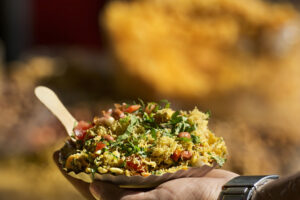When it comes to culinary adventures, India offers a vast array of flavors and textures to tantalize your taste buds. In this exploration of India’s street food, we’ll take you on a journey through the diverse world of these delectable dishes, while highlighting the importance of maintaining hygiene in their preparation.
The World of Indian Street Food
India’s street food is a vibrant tapestry woven from centuries of tradition and regional diversity. Each corner of the country boasts its own unique delicacies, making the journey through India’s street food stalls a culinary adventure. Here’s a glimpse of what you can savor:
- Savory Chaat: Chaat is a delightful mix of spicy, tangy, and sweet flavors. From Aloo Tikki to Pani Puri, every bite is a taste explosion.
- Irresistible Kebabs: Succulent kebabs, like Seekh Kebabs or Galouti Kebabs, are cooked to perfection over open flames, infusing them with a smoky flavor.
- Dosa Delights: In South India, dosa is a staple street food. These thin, crispy crepes come with an array of chutneys and sambar, creating a delightful and nutritious treat.
- Crispy Samosas: Samosas, with their crispy shell and flavorful fillings, are a beloved snack across India. Whether filled with potatoes, peas, or meat, they are a favorite snack.
- Tempting Pakoras: Pakoras, the beloved monsoon snack, come in numerous variations. Onion, potato, or spinach, these deep-fried fritters offer a comforting and flavorful experience.
 The Significance of Hygiene in Street Food
The Significance of Hygiene in Street Food
Amidst the vibrant world of Indian street food, one often underestimated element plays a crucial role: hygiene. Clean water is an essential component in ensuring the safety and hygiene of these delectable dishes.
Hygiene in Practice
Street food vendors who prioritize hygiene understand the importance of using clean water throughout their food preparation process. It is fundamental for:
- Ingredient Washing: Clean water is used to thoroughly wash fruits, vegetables, and herbs, ensuring they are free from contaminants.
- Sauce and Chutney Making: Many street food dishes rely on sauces and chutneys that contain water as a base. Clean water is vital for the preparation of these flavor-enhancing condiments.
- Beverage and Dessert Preparation: Street food includes refreshing beverages like lemonade and sweet treats like Kulfi. Clean water forms the foundation of these delightful indulgences.
- Vendor Cleanliness: Vendors themselves use clean water to maintain personal hygiene, such as washing their hands and utensils. When asking for water appeal only for bottled water.
Promoting Clean Water Practices
As a conscious consumer and street food enthusiast, there are steps you can take to ensure that you’re enjoying street food prepared with clean water:
Observe Vendor Hygiene: Look for vendors who follow hygienic practices, such as wearing gloves and using clean utensils.
Ask Questions: Don’t hesitate to inquire about the quality of water used in food preparation. Responsible vendors are usually open to discussing their practices.
Choose Bottled Water: If you’re uncertain about the water quality, opt for bottled water or packaged beverages.
A Taste of Tradition, A Lesson in Hygiene
Indian street food is a fascinating journey into the heart of a country’s culinary traditions. The diversity of flavors and techniques used is a testament to India’s rich food culture. By understanding and valuing the role of clean water in street food preparation, you contribute to the preservation of this culinary heritage while indulging your palate.
Conclusion: Savoring Responsibly
When you explore India’s street food scene, you’re not just experiencing incredible flavors; you’re immersing yourself in the culture of the country. Each bite tells a story of tradition, creativity, and the importance of cleanliness in food preparation. So, the next time you savor Indian street food, appreciate not only the taste but also the rich history behind each dish.
Also Read: Festival celebrates street food from 25 Indian states







